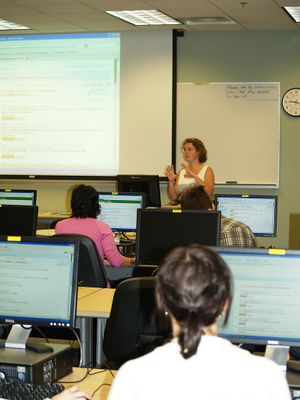MET:The teaching process
This page was originally authored by Claudia Celis (2009)
Teachers’ role in the educational process
Since the very beginning education, teachers have played one of the main roles, or even the main one in the educational process, as those who can help students to achieve what each society defines important to be learned by the youngest.

Even when teachers’ role has change through history and societies according to the particular context of each period and place, its importance has remained as the cornerstone of the educational process. Nevertheless, this role has dramatically changed in the last decades and nowadays it has been pushed to the limit and demanded to be rethought and redefined in order to respond to the actual social requirements and changes. Teachers are no longer the owners of knowledge and the idea of transmitting what they know is considered old-fashioned. So, what does this role need to be like? Which are those changes and how are teachers supposed to face them?
Moreover, if this role is expected to be redefined in traditional learning environments, it is obviously expected to be thoroughly defined when technology is to be incorporated to educational processes.
Theories about teaching
When making a literature review about the teaching process its easy to find that there are no theories that helps us to explain this complex process. Driscoll (2005, p. 23) defines instruction as “any deliberate arrangement of events to facilitate a learner’s acquisition of some goal”, and in so doing she shows why there have been no teaching theories since the very beginning of education as a formal process: Driscoll’s teaching definition –as most of them do- implies that Instruction and all what has to be with it, depends on the learning theory in which each teacher is based on, to get their own teaching definition settled.
For instance, those teachers who believe in behaviourism learning theory principles will teach in consequence and concordance with them; and so will do teachers who believe in constructivism and cognitivism theories.

Nevertheless, from any theory from which learning –an so teaching- in understood and explained, as Reigeluth (1999) has pointed out it’s quite impossible to settle a series of steps or similar to help teachers to achieve their own teaching goals. But even when there are no recipes for being a successful teacher, the instructional design theories can be considered a trustfully guide on how to lead the students to learn and develop. And even when each instructional design theory has its basis also in a learning theory, it shall give some more concrete guidance of what teachers should be doing to help their students to achieve their learning goals.
Thus, it would be recommended to first think about the learning theory in which teaching will be based, and then start looking for an instructional-design theory in order to help theory land in a concrete educational context.
The teachers' perspectives
According to Pratt, Collins and Jarvis (2001), teaching is always framed by the teachers’ actions, intentions and beliefs (which conform what they call “perspectives”) and they had suggested five different kinds of perspectives: transmission, apprenticeship, developmental, nurturing and social reform.
The authors suggested that it would be desirable that every teacher be aware of their own intentions and beliefs, so they can understand why they act as teachers as they do. In order to get this done, the authors developed an instrument which allows teachers to think about their daily teaching style and situate it in one of the five mentioned perspectives. “More importantly, it shows that when teachers examine their own profiles, they recognize themselves; and in subsequent debriefings, colleagues recognize each other in terms of their orientations to teaching as represented in their profiles.” (Pratt, Collins and Jarvis, 2001, p. 2).
You can get yourself tested and also help Pratt and his team to go on gathering information about teachers’ perspectives by answering their test at the next link:
http://teachingperspectives.com/html/tpi_frames.htm
Teachers’ perspectives definitions
According to Pratt and Collins (2007) the five perspectives on teaching are described as follows:
Developmental: From this perspective teachers are focused on the learner process. They are aimed to understand how students can develop those cognitive structures needed to learn the content.
Nurturing: Teachers situated in this perspective, give the same importance to cognitive and emotional processes. They are worried about the balance between the academic and emotional requirements, and they are looking forward keeping their students motivated and giving them the needed support.
Apprenticeship: This perspective works much as mentoring or modelling schemes do. Teachers are meant to be experts in its field, so as they are solving any problem, they are expected to show their students their own thoughts and the steps they are taking to get to the solution.
Transmission: This perspective has at least one element in common with the apprenticeship perspective in that the teacher is expected to be an expert in the content to be learned and the students are expected to reproduce what the teacher is showing them.
Social Reform: From this perspective, teachers are concerned about promoting social changes by lecturing their students. For teachers immerse in this perspective, teaching is all about awakening social consciousness and leading their students to question the current social status and structures and to find out the way to act as active social actors.
References
Driscoll, M. (2005). Psychology of learning for instruction. USA: Allyn and Bacon.
Reigeluth, C. (1999). Instructional design theories and models. Vol. II. USA: Lawrence Erlbaum Associates.
Pratt, D. and Collins, J. (2007). Five perspectives on teaching. Presented at the International PBL Syposium. Retrieved on January 20th from [1]
Pratt, D., Collins, J. and Jarvis, S. (2001). Development and use of the Teaching Perspectives Inventory (TPI). Retrieved on January 16th 2009, from [2]